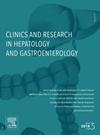Predictors and inpatient outcomes of aspiration pneumonia in patients with percutaneous endoscopic gastrostomy tube: An analysis of national inpatient sample
IF 2.6
4区 医学
Q2 GASTROENTEROLOGY & HEPATOLOGY
Clinics and research in hepatology and gastroenterology
Pub Date : 2024-09-12
DOI:10.1016/j.clinre.2024.102463
引用次数: 0
Abstract
Background
Percutaneous endoscopic gastrostomy (PEG) tubes are commonly inserted to provide a route for enteral feeding in patients who are unlikely to have adequate oral intake for prolonged periods of time. This study aims to determine the incidence of aspiration pneumonia among PEG tube patients.
Methods
We conducted a retrospective analysis of NIS database records (October 2015 to December 2020) for patients with PEG. Primary and secondary outcomes were assessed using ICD-10-CM/PCS codes.
Results
We identified a total of 2,053,560 weighted hospitalizations involving patients with PEG tube. Those with aspiration pneumonia were older (mean age 67.01 vs. 63.85, p < 0.01) and were predominantly male. At baseline, the aspiration pneumonia group had higher rates of dementia (AOR 1.22, 95 % CI: 1.19–1.24), malnutrition (AOR 1.13, 95 % CI: 1.11–1.15), cerebrovascular disease (AOR 1.29, 95 % CI 1.25–1.33), cardiac arrhythmias (AOR 1.05, 95 % CI 1.03–1.08), congestive heart failure (AOR 1.20, 95 % CI 1.17–1.24), COPD (AOR 1.18, 95 % CI 1.15–1.20), paralysis (AOR 1.06, 95 % CI 1.03–1.09), alcohol abuse (AOR 1.12, 95 % CI 1.07–1.17), and psychoses (AOR 1.07, 95 % CI 1.02–1.13). Those with aspiration pneumonia exhibited increased mortality (p < 0.01, AOR 1.59, 95 % CI 1.54–1.65), higher incidence of severe sepsis (AOR 2.03, 95 % CI 1.98–2.07) and longer hospital stays, and accrued greater hospital charges (p < 0.01). Notably, while GERD is typically considered a risk factor for AP, our findings indicated that GERD was associated with a decreased risk of AP in this patient population.
Conclusion
Patients with a PEG tube who develop aspiration pneumonia experience increased mortality rates, extended hospitalizations, a higher frequency of septic shock, and augmented healthcare consumption. Notably, old male, congestive heart failure, cerebrovascular disease, dementia, and COPD play a pivotal role in predicting these outcomes.
经皮内镜胃造瘘管患者吸入性肺炎的预测因素和住院结果:全国住院病人样本分析。
背景:经皮内镜胃造瘘管(PEG)通常用于为那些不可能长时间经口摄入足够食物的患者提供肠道喂养途径。本研究旨在确定 PEG 管患者吸入性肺炎的发病率:我们对 NIS 数据库中的 PEG 患者记录(2015 年 10 月至 2020 年 12 月)进行了回顾性分析。使用 ICD-10-CM/PCS 编码评估主要和次要结果:我们共发现了 2053560 例带 PEG 管患者的加权住院病例。患有吸入性肺炎的患者年龄较大(平均年龄为 67.01 岁 vs. 63.85 岁,P=0.01):带 PEG 管的患者如果发生吸入性肺炎,死亡率会升高,住院时间会延长,脓毒性休克的发生率会升高,医疗费用也会增加。值得注意的是,老年男性、充血性心力衰竭、脑血管疾病、痴呆症和慢性阻塞性肺病在预测这些结果方面起着关键作用。
本文章由计算机程序翻译,如有差异,请以英文原文为准。
求助全文
约1分钟内获得全文
求助全文
来源期刊

Clinics and research in hepatology and gastroenterology
GASTROENTEROLOGY & HEPATOLOGY-
CiteScore
4.30
自引率
3.70%
发文量
198
审稿时长
42 days
期刊介绍:
Clinics and Research in Hepatology and Gastroenterology publishes high-quality original research papers in the field of hepatology and gastroenterology. The editors put the accent on rapid communication of new research and clinical developments and so called "hot topic" issues. Following a clear Editorial line, besides original articles and case reports, each issue features editorials, commentaries and reviews. The journal encourages research and discussion between all those involved in the specialty on an international level. All articles are peer reviewed by international experts, the articles in press are online and indexed in the international databases (Current Contents, Pubmed, Scopus, Science Direct).
Clinics and Research in Hepatology and Gastroenterology is a subscription journal (with optional open access), which allows you to publish your research without any cost to you (unless you proactively chose the open access option). Your article will be available to all researchers around the globe whose institution has a subscription to the journal.
 求助内容:
求助内容: 应助结果提醒方式:
应助结果提醒方式:


